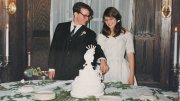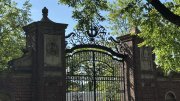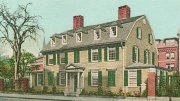...And Young. That’s the starting point of The Nancy Poems (Cirque Press, 2024), by John Morgan ’65. First, the backstory. Morgan took Robert Lowell’s poetry seminar in both his junior and senior years, and then headed from Cambridge to the Iowa Writers’ Workshop for an M.F.A. (’67). There he got his footing as a poet—in part by writing a “letter poem” to Nancy Davis, who became Nancy Davis Morgan in late 1965. The westward trajectory continued in 1976, tilted north: the couple anchored in Fairbanks, where he directed the University of Alaska’s creative writing program. (They summer at a second home in Bellingham, Washington, an arrangement some consider backwards.)
Morgan’s new volume is a portrait of a very long-term marriage. Of interest here is the foundational poem, rooted in those student days and moments, six decades-plus ago, titled, “First Date—The Sviatoslav Richter Recital,” set during the pianist’s performance at Symphony Hall, Boston:
In faint blue light, near darkness—why would he
need to see?—you sat beside me on those plush
red cushions, unaware of the arrowed heart
that brought you here. We’d talked about
your freshman classes, roommate complications,
other guys; to you we were simply friends.
How could you know the prickly cost in cash
and forethought I’d laid down? As his fingers
probed a minor Haydn run, easy for others,
but for him a brooding philosophic reach,
I watched your supple hand near mine and,
though my hidden hopes had already
knit our lives together, set the thought
of holding it aside as premature.
In these turbulent times, it’s good to know things worked out. Happy sixtieth reunion, John, and anniversary, John and Nancy.
Primus recently enjoyed Amy Reading’s estimable The World She Edited: Katharine S. White at The New Yorker, where he met Elizabeth Shepley Sergeant, KSW’s oldest sister and author of several penetrating profiles for other magazines, collected as Fire Under the Andes (1927). It took but a few keystrokes in the Harvard Library’s HOLLIS system to locate the title.
Chapter XI, “Scientist in Armour” (remember, this was 1927), is on Alice Hamilton, this issue’s Vita subject. “Can you see the woman” with that Scotch-Irish name, Sergeant begins—“a lady in the early fifties with dusky black hair turned grey, hazel eyes serene and searching, profile of a classic gravity and purity—moving quietly about a square New England house that rises high among its elms above a wide, slow-flowing river…?”
After that languid opening, Sergeant gets down to business, describing “the leading American expert in one of the newest fields of scientific medicine: a doctor who…has been able to mitigate the danger of the lives on which American industry rests.” Hamilton segued from boarding in the “gentle shelter” of Miss Porter’s school to medical training at the University of Michigan to immersion in social problems at Hull House and then to government service, cultivating “an intense and humane concern for people who have small chance in this world.”
Everywhere, she was an educator. Per Sergeant, “She tells a story of a lead plant where conditions were peculiarly outrageous, the air thick with white lead dust; no facilities for washing, no lunch rooms. The superintendent…perceiving her distress, said consolingly: ‘Well, we’ve got one place here you’ll like’—and he conducted her to a luxurious white-tiled stable, full of sleek animals. ‘There’s nothing,’ he said, ‘Mr. Blank wouldn’t do for his horses.’” (Tutored, said boss “made all the changes that the doctor suggested.”)
There is much to recommend this exhumation from the stacks: the quality of Hamilton’s science and her beneficial use of it, the worth of safety regulation and public service—and the value of Harvard’s library collections, a reliable source of knowledge when people realize they need it. Right now, all those things seem especially to matter.









